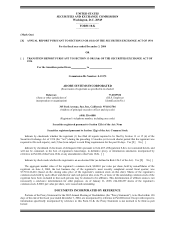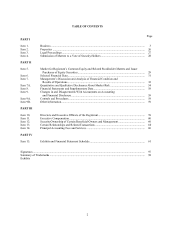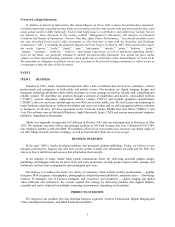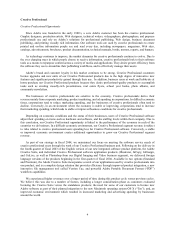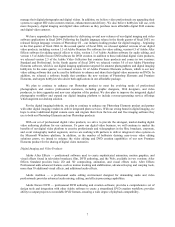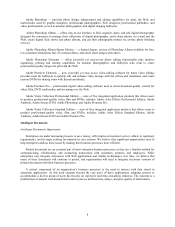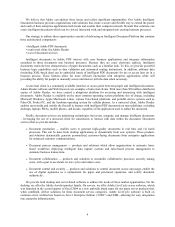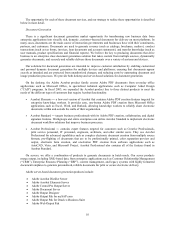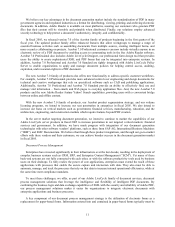Adobe 2004 Annual Report Download - page 11
Download and view the complete annual report
Please find page 11 of the 2004 Adobe annual report below. You can navigate through the pages in the report by either clicking on the pages listed below, or by using the keyword search tool below to find specific information within the annual report.11
We believe our key advantages in the document generation market include the standardization of PDF in many
government agencies and regulated industries as a format for distributing, viewing, printing, and archiving electronic
documents. In addition, Adobe Reader is available on most platforms, assuring our customers who generate PDF
files that their content will be viewable and printable when distributed. Finally, our solutions employ advanced
security technology to help protect a document’s authenticity, integrity, and confidentiality.
In fiscal 2005, we released version 7.0 of the Acrobat family of products beginning in the first quarter of the
fiscal year. The updated product family offers enhanced features that allow workgroups to manage a range of
essential business activities such as assembling documents from multiple sources, creating intelligent forms, and
more securely collaborating on projects. Acrobat 7.0 Professional customers can now include virtually anyone in an
electronic review of a PDF document by enabling access to commenting tools in the free Adobe Reader software.
Acrobat 7.0 Professional also includes Adobe LiveCycle Designer, our professional form design tool that provides
users the ability to create sophisticated XML and PDF forms that can be integrated into enterprise systems. In
addition, Acrobat 7.0 Professional and Acrobat 7.0 Standard are tightly integrated with Adobe LiveCycle Policy
Server to enable organizations to apply and manage document policies for helping control access, auditing,
expiration, and revocation rights in a PDF document.
The new Acrobat 7.0 family of products also offers new functionality to address specific customer workflows.
For example, Acrobat 7.0 Professional provides more advanced control over engineering and design documents for
technical and creative workgroups that rely on specialized software such as CAD and publishing applications.
Additionally, Acrobat 7.0 Professional and Acrobat 7.0 Standard provide an ability to effectively find, use and
manage vital information – from emails and Web pages to everyday application files. And, the new Acrobat 7.0
products and the new Adobe Reader feature Yahoo! Search capabilities, providing users with a convenient bridge
between online and offline content.
With the new Acrobat 7.0 family of products, our Acrobat product segmentation strategy, and our volume
licensing programs, we intend to increase our seat penetration in enterprises in fiscal 2005. We also intend to
increase our focus on vertical markets such as government, financial services, manufacturing, education, and the
architecture, engineering, and construction markets which require features beyond PDF creation.
In the server market targeting document generation, we intend to continue to market the capabilities of our
Adobe LiveCycle server products in fiscal 2005 to increase penetration in our targeted vertical markets: financial
services and government. In addition, we have made progress with integration of our document generation
technologies with other software vendors’ platforms, such as those from SAP AG, International Business Machines
(“IBM”), and EMC Documentum. We believe that through these product integrations, and through our go-to-market
efforts with these vendors and their customers, we can achieve broader success in the document generation market
in fiscal 2005.
Document Process Management
Enterprises have invested significantly in their infrastructure over the last decade, resulting in the deployment of
complex business systems such as CRM, ERP, and Enterprise Content Management (“ECM”). Yet many of these
back-end systems are not fully connected with each other, or with the software productivity tools used by business
users on their desktops. To fully realize the power of core applications, enterprises must extend the reach of these
applications with processes that enable the secure capture and interaction with data. They also must be able to
automate, manage, and track the processes that rely on that data to increase internal operational efficiencies, while at
the same time meet compliance mandates.
To meet these challenges, we offer, as part of our Adobe LiveCycle family of document services, document
process management solutions that leverage the intelligence and flexibility of intelligent PDF documents. By
combining the business logic and data exchange capabilities of XML with the security and reliability of Adobe PDF,
our process management solutions makes it easier for organizations to integrate electronic documents with
enterprise applications and business processes.
A key component of our document process management strategy is the utilization of electronic forms as a
replacement for paper-based forms. Information entered into and contained in paper-based forms typically must be

